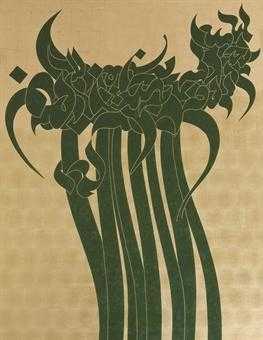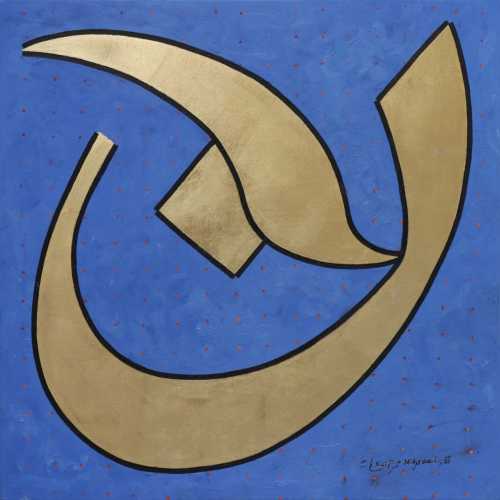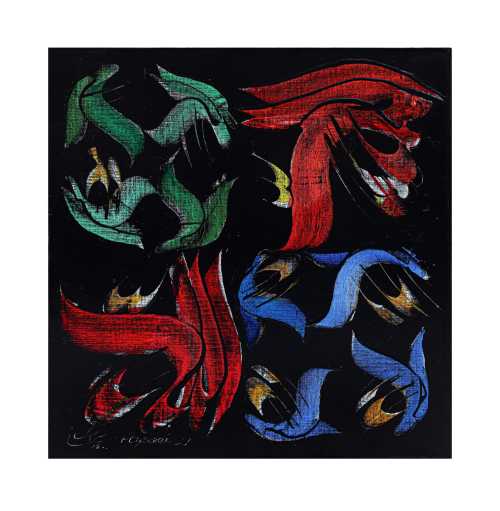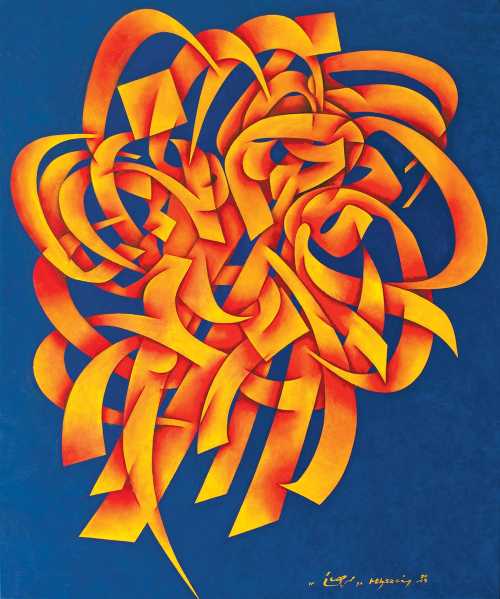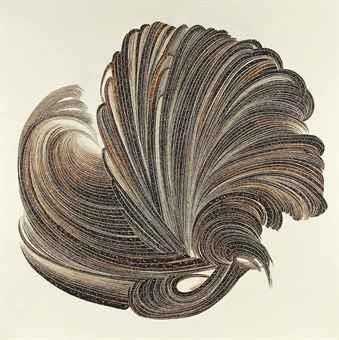- A Bunch of Daffodils 2008
- Oil and gold leaf on canvas
- Painting, Calligraphy Painting
- 185 * 250 cm
- signed and dated in Farsi and dated '1976-2008' (lower left)
Artwork Description
"In 1976, at the order of Iranian Broadcasting Organization, an album containing 10 works by 10 painters and graphic designers was produced. Then some 200 silk screen volumes of this fine album were presented to the guests of the Shiraz Art Festival. Among them was my work of 70x100cm with inscriptions and symbols in black gouache on cardboard which I had painted for a friend.
A few years later, I changed its composition by adding or omitting some words and letters, and finally re-painted it with oil and gold folio on canvas last year.
The previous painting, which I dedicated to the citizens of Shiraz, alluded to Daffodils of Shiraz. Now I would like to dedicate this new version with its graphic elements turned into a painting to you."
(Mohammad Ehsai)
Mohammed Ehsai represents the continuation of an artistic movement which sought to leave its mark by combining traditional techniques into a modern artistic form. Applying calligraphy as the main element of his works, he tends to utilize his knowledge of graphic arts to create impressive pictures. Other than traditional Persian calligraphy, Eshai's works can be divided into two categories: Calligraphy-Paintings and the Eternal Alphabet.
In his Calligraphy Paintings, Ehsai is engaged in a visual language strongly influenced by structural calculations and the use of calligraphy in architecture, which have enjoyed a long history in Islamic art. Here Ehsai offers a new interpretation of the tradition of graphic arts by transforming coloration, execution and the use of material in a reconfigured sphere that has been made possible by modern graphics. Those pieces which represent a painterly technique with more personal focus tend to convey the artistic passion of the artist, including black and white pictures bearing long alifs (the first letter of the Arabic/Persian alphabet), filled in between with other letters, smaller and denser in their composition.
The significance of these works lies in their ability to create abstract forms through the use of lines. The austere distribution of words within the frame is indicative of a supreme order derived from centuries of utopian idealism within religion. Since the written word has historically been used as a tool for the documentation and transfer of knowledge, each written piece, before even being read, holds an intellectual weight. As such, the presence of written forms and words in an artistic creation, let alone in calligraphic art, places that piece in a symbolic order of meaning.
Time does not have circular nature in these works as it looks linear. Even in the most twisted forms one can still trace back to the point of departure by following the line. Repetitions are fundamental and evidently regulated as calligraphic forms are not scattered. Time is never represented in vague terms; rhythms are clear and can be followed, albeit by way of a detour.
"I have culled reporting and narration from 'the written word'", says Ehsai, "making the form of the letter the main element of my work; in this way, I have achieved individual compositions which are essentially visual structures based on the architecture of letters".
Some of Ehsai's works are in white and black, which somehow suggests a dualistic universe. In general, Ehsai's works are either monochromatic or in limited chiaroscuro. At most these works are created through the use of two or three colours. This economy of colour is another characteristic of the artist's work.
A few years later, I changed its composition by adding or omitting some words and letters, and finally re-painted it with oil and gold folio on canvas last year.
The previous painting, which I dedicated to the citizens of Shiraz, alluded to Daffodils of Shiraz. Now I would like to dedicate this new version with its graphic elements turned into a painting to you."
(Mohammad Ehsai)
Mohammed Ehsai represents the continuation of an artistic movement which sought to leave its mark by combining traditional techniques into a modern artistic form. Applying calligraphy as the main element of his works, he tends to utilize his knowledge of graphic arts to create impressive pictures. Other than traditional Persian calligraphy, Eshai's works can be divided into two categories: Calligraphy-Paintings and the Eternal Alphabet.
In his Calligraphy Paintings, Ehsai is engaged in a visual language strongly influenced by structural calculations and the use of calligraphy in architecture, which have enjoyed a long history in Islamic art. Here Ehsai offers a new interpretation of the tradition of graphic arts by transforming coloration, execution and the use of material in a reconfigured sphere that has been made possible by modern graphics. Those pieces which represent a painterly technique with more personal focus tend to convey the artistic passion of the artist, including black and white pictures bearing long alifs (the first letter of the Arabic/Persian alphabet), filled in between with other letters, smaller and denser in their composition.
The significance of these works lies in their ability to create abstract forms through the use of lines. The austere distribution of words within the frame is indicative of a supreme order derived from centuries of utopian idealism within religion. Since the written word has historically been used as a tool for the documentation and transfer of knowledge, each written piece, before even being read, holds an intellectual weight. As such, the presence of written forms and words in an artistic creation, let alone in calligraphic art, places that piece in a symbolic order of meaning.
Time does not have circular nature in these works as it looks linear. Even in the most twisted forms one can still trace back to the point of departure by following the line. Repetitions are fundamental and evidently regulated as calligraphic forms are not scattered. Time is never represented in vague terms; rhythms are clear and can be followed, albeit by way of a detour.
"I have culled reporting and narration from 'the written word'", says Ehsai, "making the form of the letter the main element of my work; in this way, I have achieved individual compositions which are essentially visual structures based on the architecture of letters".
Some of Ehsai's works are in white and black, which somehow suggests a dualistic universe. In general, Ehsai's works are either monochromatic or in limited chiaroscuro. At most these works are created through the use of two or three colours. This economy of colour is another characteristic of the artist's work.
More lots by Mohammad Ehsai
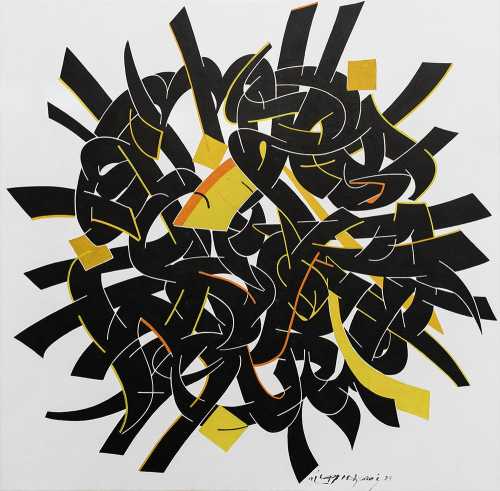
The Autumn of Sunflower
Estimation
20,000,000,000﷼
40,000 USD
-
30,000,000,000﷼
60,000 USD
Realized Price
41,800,000,000﷼
83,600 USD
67.2%
Sale Date
Tehran
-
12 December 2023
Realized Price
122,038 USD
Min Estimate
72,125 USD
Max Estimate
101,716 USD
Average Artwork Worth
+62.555%
Average Growth of Artwork Worth
Sales Performance Against Estimates
Average & Median Sold Lot Value
2021 - 2025
Performance vs. Estimate
2021 - 2025
Sell-through Rate
2021 - 2025
